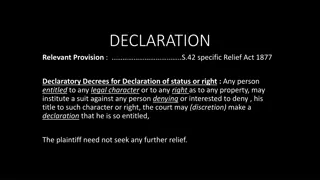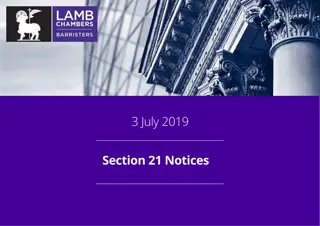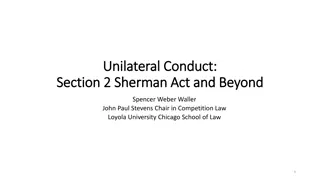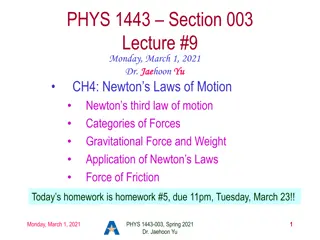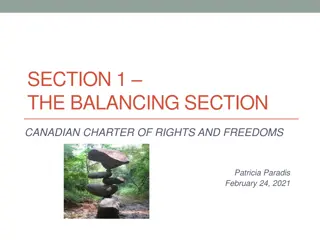Understanding Section 1 of the Sherman Act and Antitrust Laws
Section 1 of the Sherman Act prohibits contracts, combinations, or conspiracies that restrain trade or commerce among states or with foreign nations. Violations can result in felony charges, fines, and imprisonment. The section covers various antitrust practices such as price fixing, market division, competitor collaboration, and more. Cases like Copperweld Corp. v. Independence Tube Corp. and Monsanto Co. v. Spray-Rite Service Corp. provide insights into proving agreements in antitrust cases.
Download Presentation

Please find below an Image/Link to download the presentation.
The content on the website is provided AS IS for your information and personal use only. It may not be sold, licensed, or shared on other websites without obtaining consent from the author. Download presentation by click this link. If you encounter any issues during the download, it is possible that the publisher has removed the file from their server.
E N D
Presentation Transcript
Section 1 of the Sherman Act at the Antitrust Boot Camp sponsored by The Center for State Enforcement of Antitrust and Consumer Protection Laws, Inc. Loyola University Chicago School of Law By Stephen Calkins Professor, Wayne State U Law School Former General Counsel, FTC Former Member of Ireland s Competition and Consumer Protection Commission
Welcome (?) to Antitrust California Dental Ass n v. FTC, 526 U.S. 756 (1999) (5-4) Ohio v. American Express Co., 138 S. Ct. 22734 (June 25, 2018) (5-4) Apple Inc. v. Pepper, 139 S. Ct. 1514 (May 13, 2019) (5-4)
Section 1 Every contract, combination . . . or conspiracy, in restraint of trade or commerce among the several States, or with foreign nations, is declared to be illegal. Every person who [violates this rule] . . . shall be deemed guilty of a felony, and . . . shall be punished by fine not exceeding $100,000,000 if a corporation, or, if any other person, $1,000,000, or by imprisonment not exceeding 10 years, or by both . . . .
Section 1 includes: Price fixing Market division Competitor collaboration Boycotts Per se/Rule of Reason/Quick look RPM Tying Exclusive dealing/sole outlet/distribution Two-sided markets Etc.
The essential thing is what comes first: Every contract, combination . . . or conspiracy . . . .
Every contract, combination . . . or conspiracy . . . . Multiple actors Agreement
Multiple Actors Copperweld Corp. v. Independence Tube Corp., 467 U.S. 752 (1984) (are there separate economic actors pursuing separate economic interests so the agreement deprives the marketplace of independent centers of decisionmaking ) American Needle, Inc. v. National Football League, 560 U.S. 183 (2010) Medical Center at Elizabeth Place, LLC v. Atrium Health System, 817 F.3d 934 (6thCir. 2016) (2-1)
Proof of Agreement Monsanto Co. v. Spray-Rite Service Corp., 465 U.S. 752 (1984) ( evidence that tends to exclude the possibility that the [defendants] were acting independently ) Matsushita Elec. Indus. Co. v. Zenith Radio Corp., 475 U.S. 574 (1986) (same, horiz SJ) Bell Atlantic Corp. v. Twombly, 550 U.S. 544 (2007) ( plausibility and the need for something more than merely parallel behavior ) (motion to dismiss)
Very Hard to Prove Agreement Quality Auto Painting Center, Inc. v. State Farm Indemnity Co., 917 F.3d 1249 (11thCir. 2019) (en banc) Kleen Products LLC v. Georgia-Pacific LLC, 910 F.3d 927 (7thCir. 2018) (Wood, J.) Anderson News, L.L.C. v. American Media, Inc., 899 F.3d 87 (2d Cir. 2018) Valspar Corp. v. E.I. Du Pont De Nemours and Co., 873 F.3d 185 (3d Cir. 2017) Evergreen Partnering Group, Inc. v. Pactiv Corp., 832 F.3d 1 (1stCir. 2016) But see Gelboim v. Bank of America Corp., 823 F.3d 759 (2d Cir. 2016).
Caveat Bell Atlantic Corp. v. Twombly, 550 U.S. 544 (2007) (Thus, it is one thing to be cautious before dismissing an antitrust complaint in advance of discovery, cf. Poller v. Columbia Broadcasting Sys., Inc., 368 U.D. 464, 473 (1962), but quite another to forget that proceeding to antitrust discovery can be expensive. . . . Probably, then, it is only by taking care to require allegations that reach the level suggesting conspiracy that we can hope to avoid the potentially enormous expense of discovery in cases with no reasonably founded hope that the [discovery] process will reveal relevant evidence to support a 1 claim. . . . .)
Interstate or Foreign Commerce . . . in restraint of trade or commerce among the several States, or with foreign nations . . . . Summit Health, Ltd. v. Pinhas, 500 U.S. 322 (1991) (5-4) (Stevens; dissent by Scalia). FTAIA (import commerce or commerce with a direct, substantial and reasonably foreseeable effect) Animal Science Products, Inc. v. Hebei Welcome Pharmaceutical Co., 138 S. Ct. 1865 (2018)
Per Se Rules FTC v Superior Court Trial Lawyers Ass n, 493 U.S. 411 (1990) (6-3, in part).
Clearly Per Se Agreements Price fixing Bid Rigging Customer or Market Division (caveat) Output restrictions But see Broadcast Music, Inc. v. CBS, 441 U.S. 1 (1979) ( whether the practice facially appears to be one that would always or almost always tend to restrict competition and decrease output ); Rothery Storage & Van Co. v. Atlas Van Lines, Inc., 792 F.2d 210 (DC Cir. 1986 ) (Bork, J.)
Market Division? United States v. Topco Associates, 405 U.S. 596 (1972) Palmer v. BRG of Georgia, Inc., 498 U.S. 46 (1990) (per curiam) Blackburn v. Sweeney, 53 F.3d 825 (7thCir. 1995) (Cummings) (law firm advertising) Polk Bros., Inc. v. Forest City Enterprises, Inc., 776 F.2d 185 (7thCir. 1985) (Easterbrook) General Leaseways, Inc. v. National Truck Leasing Ass n, 744 F.2d 588 (7thCir. 1984) (Posner)
Nominally Per Se Certain group boycotts, see Northwest Wholesale Stationers, Inc. v. Pacific Stationery and Printing Co., 472 U.S. 284 (1985) ( certain concerted refusals to deal or group boycotts per se) Fashion Originators Guild of Am. v. FTC, 312 U.S. 457 (1941) (Discon said a group boycott in the strongest sense ) ( the combination is in reality an extra- governmental agency, which prescribes rules for the regulation and restraint of interstate commerce, and provides extra-judicial tribunals for determination and punishment of violations . . . . Eastern States Retail Lumber Dealers Ass n v United States, 234 U.S. 600 (1914) (circulation of reports)
Nominally per se, cont.: Tying? International Salt Co. v. United States, 332 U.S. 392 (1947). Jefferson Parish Hosp. v. Hyde, 466 U.S. 2 (1984) (2 products, one w. sufficient power to force, tied, and not insubstantial amt commerce). But cf. Illinois Tool Works Inc. v. Independent Ink, Inc., 547 U.S. 28 (2006).
Per Se or Nothing? United States v. Kemp & Assocs. (D. Utah Feb. 21, 2019) (criminal market division, on remand and motion to reconsider) Medical Center at Elizabeth Place, LLC v Atrium Health Sys., 922 F.3d 713 (6thCir. April 25, 2019) (Batchelder, J.; partial dissent by White) (after remand and after reconsideration): If . . . the record indicates that the challenged restraint is plausibly procompetitive, then summary judgment for the defendants is appropriate. (??)
Horizontal Rule of Reason Board of Trade of City of Chicago v. United States, 246 U.S. 231 (1918) NCAA v. Board of Regents, 468 U.S. 85 (1984) National Soc y of Professional Engineers v. United States, 435 U.S. 679 (1978) FTC v. Indiana Federation of Dentists, 476 U.S. 447 (1986) FTC v. Actavis, Inc., 570 U.S. 136 (2013) Ohio v. American Express Co., 138 S. Ct. 2274 (2018)
RR Three Step (see Amex) plaintiff has the initial burden to prove that the challenged restraint has a substantial anticompetitive effect that harms consumers in the relevant market. the burden shifts to the defendant to show a procompetitive rationale for the restraint. the burden shifts back to the plaintiff to demonstrate that the procompetitive efficiencies could be reasonably achieved through less anticompetitive means.
Direct Proof? Amex: Indirect evidence would be proof of market power plus some evidence that the challenged restraint harms competition. Direct evidence of anticompetitive effects would be proof of actual detrimental effects [on competition], [IFD]. such as reduced output, increased prices, or decreased quality in the relevant market See Toys R Us, Inc. v. FTC, 221 F.3d 928 (7th Cir. 2000) (Wood, J.)
Quick Look/Inherently Suspect Vogel v. American Soc y of Appraisers, 744 F.2d 598 (7thCir. 1984) (Posner, J.) California Dental Ass n v. FTC, 526 U.S. 756 (1999) (5-4) ( only where an observer with even a rudimentary understanding of economics could conclude that the arrangements in question would have an anticompetitive effect ). Polygram Holding, Inc. v. FTC, 416 F.3d 29 (D.C. Cir. 2005) ( inherently suspect ) In re 1-800 Contacts, Inc. (FTC Nov. 7, 2018) (3-1) (on appeal)
Vertical Rule of Reason: Distribution Continental T.V., Inc. v. GTE Sylvania Inc., 433 U.S. 36 (1977) United States v. Colgate & Co., 250 U.S. 300 (1919) ( In the absence of any purpose to create or maintain a monopoly, the act does not restrict the long recognized right of a trader . . . freely to exercise his own independent discretion as to parties with whom he will deal; and, of course, he may announce in advance the circumstances under which he will refuse to sell. ) Business Electronics Corp. v. Sharp Electronics Corp., 485 U.S. 717 (1988)
Vertical RR: Resale Price Maintenance Dr. Miles Medical Co. v. John D. Park & Sons Co., 220 U.S. 373 (1911) Maximum RPM: State Oil Co. v. Khan, 522 U.S. 3 (1997) Minimum RPM: Leegin Creative Leather Prods., Inc. v. PSKS, Inc., 551 U.S. 877 (2007) In re Disposable Contact Lens Antitrust, 329 F.R.D. 336 (M.D. Fla. Dec. 4, 2018) (certifying classes) ( unilateral pricing policy under federal and state law)
Vertical RR: Exclusive Dealing Tampa Electric Co. v. Nashville Coal Co., 365 U.S. 320 (1961) United States v. Dentsply Int l, Inc., 399 F.3d 181 (2005) ( 2) In re McWane, Inc., Dkt. 9351 (FTC 2014) (3-1) (monopolization) (significant portion of distrib. covered; entry barriers or impediments; prolong dominant position), aff d, 783 F.3d 814 (11thCir. 2015) (3-0), cert denied March 2016. Beltone Electronics Corp., 100 F.T.C. 68, 204 (1982) ZF Meritor, LLC v. Eaton Corp., 696 F.3d 254 (3d Cir. 2012):
ZF Meritor: modern antitrust law generally requires a showing of significant market power substantial foreclosure contracts of sufficient duration an analysis of likely or actual anticompetitive effects . Maybe coercive behavior Maybe ability to terminate Maybe use by competitors
Can Vertical RR be Horizontal? Yes, see Toys R Us, Inc. v. FTC, 221 F.3d 928 (7th Cir. 2000) (Wood, J.) Cf. In re Disposable Contact Lens Antitrust, 329 F.R.D. 336 (M.D. Fla. Dec. 4, 2018) (certifying horizontal and vertical classes) Cf. In re Blue Cross Blue Shield Antitrust Litig., 308 F. Supp. 3d 1241 (N.D. Alabama 2018) (association rules as horizontal)
Non-Compete Clauses DOJ Statement of Interest, Stigar v. Dough Dough, Inc. (E.D. Wash. filed March 7, 2019) (rejecting franchise hub-and-spoke) Washington AG amicus brief, Stigar, filed March 11, 2019 (state antitrust not mirror images; 50 franchisors have discontinued; state court has refused to dismiss; burden on D to show reasonably necessary to legit transaction) AAI Letter to DOJ: Horiz effects and no signif. efficiencies, followed by Butler v. Jimmy John s (S.D. Ill. May 21, 2019) (refusing to dismiss)
Non-compete Clauses, cont. Cf. Pittsburgh Logistics Sys., Inc. v. BeeMac Trucking, LLC, 202 A.3d 801 (Pa. Superior Ct. 2019) (en banc; 7-2) (no-hire restrictions between contracting companies void against state public policy)
Section 1 of the Sherman Act at the Antitrust Boot Camp sponsored by The Center for State Enforcement of Antitrust and Consumer Protection Laws, Inc. Loyola University Chicago School of Law By Stephen Calkins Professor, Wayne State U Law School Former General Counsel, FTC Former Member of Ireland s Competition and Consumer Protection Commission
References (other than Areeda & H) Ernest Gellhorn, William E. Kovacic & Stephen Calkins, Antitrust Law and Economics in a Nutshell (5thed. 2004). FTC Guidance on Anticompetitive Practices, https://www.ftc.gov/enforcement/anticompetitiv e-practices FTC/DOJ Competitor Collaboration Guidelines, https://www.ftc.gov/sites/default/files/documen ts/public_events/joint-venture-hearings- antitrust-guidelines-collaboration-among- competitors/ftcdojguidelines-2.pdf DOJ Antitrust Primer for Federal Law Enforcement Personnel (2018), https://www.justice.gov/atr/page/file/1091651/d ownload
More References DOJ Leniency Program (FAQs, Policies, Model Letters, Speeches, etc.), https://www.justice.gov/atr/leniency-program DOJ/FTC Guidance for Human Resource Professionals (2016), https://www.ftc.gov/public- statements/2016/10/antitrust-guidance- human-resource-professionals-department- justice
And More DOJ/FTC Statements of Antitrust Enforcement Policy in Health Care (1996), https://www.ftc.gov/sites/default/files/attachme nts/competition-policy- guidance/statements_of_antitrust_enforcement_ policy_in_health_care_august_1996.pdf DOJ/FTC Antitrust Guidelines for the Licensing of Intellectual Property (2017), https://www.ftc.gov/system/files/documents/pu blic_statements/1049793/ip_guidelines_2017.pd f Calkins, Reflections on Matsushita and Equilibrating Tendencies, 82 Antitrust L.J. 15 (2018)






